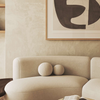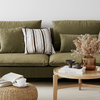What's the Difference Between Scandinavian and Nordic Style?
- by Lynsey Woodward
Scandinavian and Nordic styles are two of the most popular interior design approaches, known for their simplicity and timeless appeal. While they share many similarities, there are clear distinctions that set them apart. By understanding these differences, you can decide which style suits your home and personality best.
Defining Scandinavian and Nordic Design
Scandinavian design originates from Denmark, Sweden, and Norway. It emerged during the 20th century and became famous for its "function meets beauty" philosophy. This style focuses on clean lines, practical furniture, and bright spaces to combat the dark, long winters of these countries. White walls, light wood tones, and simple yet functional furniture are common features of Scandinavian interiors.

Learn more about Scandi style in our dedicated guide about the basics of Scandinavian design.
On the other hand, Nordic design represents the broader Nordic region, which includes Finland and Iceland alongside the Scandinavian countries. While Nordic interiors also value simplicity and functionality, they lean more toward rustic elements and a cosy, inviting atmosphere. There’s a stronger emphasis on handmade crafts, earthy tones, and natural textures that give Nordic interiors a warmer, more personal feel.
Both styles celebrate nature and incorporate natural light and materials. However, where Scandinavian design feels sleek and modern, Nordic design often adds a touch of tradition and warmth.
Similarities Between Scandinavian and Nordic Design
At first glance, Scandinavian and Nordic designs might seem nearly identical. Both styles focus on creating functional, uncluttered spaces that feel calm and relaxing. They are perfect for anyone who loves minimalism but still wants their home to feel cosy.
Key Similarities
Minimalism
Both styles embrace the “less is more” concept. Interiors are free from clutter, with only essential furniture and décor pieces. Everything serves a purpose, ensuring the space feels open and airy.

Natural Materials
Wood is a key material in both Scandinavian and Nordic interiors. Light oak, birch, and pine are especially popular, as they bring warmth without overwhelming the space. Other natural materials like wool, leather, and linen also appear frequently.
Connection to Nature
Interiors in both styles maximise natural light through large windows and light colours. They aim to blur the boundary between indoors and outdoors, often adding plants or incorporating nature-inspired artwork.
For example, a wooden coffee table like our Laudal Coffee Table works beautifully in either style. Its simple design makes it a versatile choice for any home inspired by Nordic or Scandinavian aesthetics.
Differences Between Scandinavian and Nordic Design
While Scandinavian and Nordic styles share core principles, the differences lie in the details. These subtle contrasts can help you choose the right look for your home.
Colour Palette
Scandinavian Design:
Scandi interiors are famous for their light and neutral colour schemes. Whites, greys, and beige dominate, helping to make rooms feel bright and open. This approach reflects the need to maximise daylight during long winters.
Nordic Design:
Nordic style uses a slightly broader colour palette. While it still includes neutral tones, it often incorporates deeper hues inspired by nature, such as forest greens, earthy browns, and icy blues. These colours add depth and warmth to spaces.
Textures and Layers
Scandinavian Design:
Scandinavian spaces are sleek and polished, often with smooth, modern finishes. The emphasis is on keeping things minimal yet cosy, using soft textiles like throws and cushions to add warmth.
Nordic Design:
Nordic interiors place a stronger focus on handcrafted elements. You’ll find raw, unpolished wood, chunky knits, and rustic textures that give the space a homely feel. These details highlight tradition and craftsmanship.

Aesthetic Focus
Scandinavian Design:
Scandinavian interiors prioritise functionality above all else. Furniture is practical and streamlined, designed to meet modern living needs without being flashy. There’s a heavy focus on timeless pieces that will last for years.
Nordic Design:
Nordic style balances minimalism with warmth. While it still values clean lines, there’s a greater focus on storytelling through décor. Handmade items, like woven rugs or pottery, are often used to create a connection to tradition and history.
How to Bring These Styles Into Your Home
If you prefer bright, simple spaces, Scandinavian design might be your perfect match. Start by choosing furniture with clean lines and light wood finishes. Pair this with neutral-toned textiles, like a white throw or grey cushions, for a cosy but uncluttered look.
To embrace Nordic style, focus on textures and warmth. Add a soft knitted blanket, rustic wooden shelves, or even bold patterned rugs to create a homely, lived-in atmosphere.
A grey sofa, like our Larvik Chaiselongue Sofa can easily adapt to both styles - use soft cushions for a Scandi look or a chunky wool throw for Nordic charm.
Combining both styles is also a great option. You can mix clean-lined furniture with warm, handmade elements to create a space that feels unique and personal.
Scandinavian and Nordic styles are both rooted in simplicity, nature, and functionality. However, Scandinavian design leans toward sleek, modern minimalism, while Nordic interiors embrace tradition, warmth, and bold accents.
Understanding these differences can help you bring the perfect balance of style and comfort into your home. If you’re looking to create a beautiful and timeless interior, explore our collection of timeless furniture.




